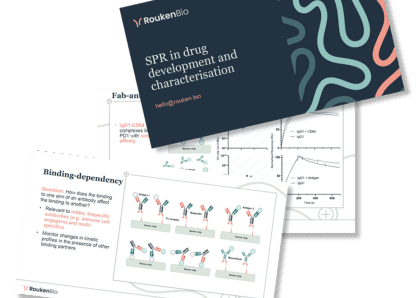Ensuring high-quality proteins for accurate SPR assays: key considerations
Like most analytical assays, the quality of the starting material can heavily influence the results obtained. Poor quality proteins, and the solutions they are formulated in, can adversely affect measurements and ultimately the data quality and/or the microfluidics of the system.

|
October 11, 2022
|
6 min read
Surface plasmon resonance is a powerful label-free biophysical technique used to study and quantify biomolecular interactions. Like most analytical assays, the quality of the starting material can heavily influence the results obtained. Although a multitude of molecules can be investigated using SPR, in the realm of biotherapeutics, proteins are always part of the equation. Poor quality proteins, and the solutions they are formulated in, can adversely affect measurements and ultimately the data quality and/or the microfluidics of the system. As such, it is essential that your proteins are good quality.
Our slides below detail more about the surface plasmon resonance capabilities we can provide.
So, what does this mean and how can you ensure you choose the best protein for your assay to achieve beautiful results? Stack the odds in your favour by considering a few key points.
Sample purity in SPR assays
Sample purity considerations may differ depending upon which molecule is the ligand (attached to the surface) and which molecule is the analyte (in solution). When amine coupling of your sample is the only immobilisation choice, purity and homogeneity must be exceptional, > 95% purity is essential (as determined by SDS-PAGE). If, however, your ligand is being coupled to the surface using a capture strategy, the purity is not as important as the capture process will act as a mini-purification step.
It follows then that the purity of the analyte must be >95% as impurities in the analyte can wreak havoc on your experiments. Impurities such as protein aggregates or unfolded protein can cause noisy signals, curious looking sensorgrams, inaccurate concentration determinations and result in the over or underestimation of kinetic values.
Additional QC from the supplier is preferrable, such as SEC-MALS, which gives an extra level of confidence in the protein quality as this is a demonstration of both protein purity and confirmation of size (under non-reducing conditions).
Sample formulation and SPR sensorgrams
It is very important to be aware of sample buffer composition. Even the smallest differences in the sample or running buffer can cause bulk shift in sensorgrams. Similarly, excipients used in some therapeutic formulations or recombinantly expressed proteins can be troublesome; cyclics such as sucrose, trehalose and even histidine are known to absorb in the spectrum used by SPR systems. Again, formulation is less important when the sample is the ligand and plays a much more pertinent role when present in the analyte preparation. Be aware that elaborate buffers may be a sign that the protein you are working with is inherently unstable. In these cases, the assay running buffer needs to be carefully chosen.
Source of proteins in use of assays
Knowing the source of your protein is a definite must. Species-specific post-translational modifications such as glycosylation play a very important role in protein function when present. The sequence and organism used to produce the protein, as well as any tags present on your protein post purification, including their position on the protein, C- or N-terminal, are very important considerations.
Protein function in SPR assays
Lastly, and most importantly is confirmation of bioactivity. High purity protein, SPR compatible buffer and protein source become meaningless if the protein is not functional. If a supplier can back their protein with verified activity, you are enroute to a winning assay.
If you can tick all these boxes, chances are that your SPR assay has a good chance of giving you the results you are looking for (perhaps there may be a few tweaks that need to be made along the way).
Join our community of curious minds on LinkedIn
🗓️ Stay informed with our monthly scientific newsletter, published on LinkedIn on the last Wednesday of each month.
These editions bring you the latest in drug development breakthroughs, industry trends, and expert insights from the brilliant minds at RoukenBio.
Subscribe today on LinkedInFind out more about our custom SPR assays
Understanding target binding kinetics is critical to tuning molecule efficacy. Great therapeutic candidates should achieve the optimum affinity and antigen specificity. Learn more about our SPR capabilities in our technical presentation.
Access the technical presentation

